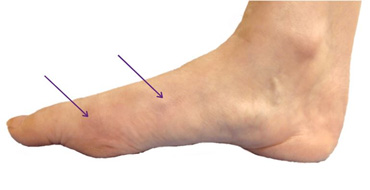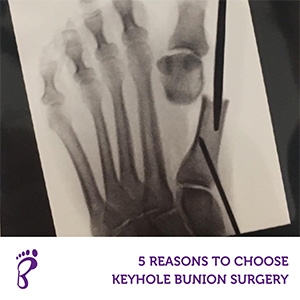Keyhole or minimally-invasive surgery is performed using specialised instruments, inserted through small incisions, all under the guidance of an x-ray machine. This is the technique that I use for all my bunion surgeries, as opposed to the traditional 'open' or ‘scarf’ techniques.
In this month's blog post, I take you through 5 key benefits of the minimally-invasive approach to bunion correction
1) Minimal Scarring
With traditional open surgery, a large cut is used to gain access to the bone and can be up to 10cm or more. With keyhole surgery, only tiny incisions of 2-5mm are used. There will still be scars, but just very small ones, almost impossible to see after one year, as you can see from the image below.

2) Faster Recovery and Return to Normal Activities
Since only tiny incisions allow for access to the bones in minimally-invasive bunion surgery, bones can be re-shaped, straightened and pinned without the need to extensively cut other tissues, muscle and skin. Traditional open surgery goes through all of these layers to reach the bunion. Healing of the subsequent large wound causes stiffness and swelling which can be a hindrance in terms of pain and recovery time.
3) Reduced Recurrence Rates
Keyhole bunion surgery theoretically has longer lasting benefits than some open surgery techniques for a number of technical reasons. One of these is that the keyhole technique locks out the first tarsometatarsal joint, which causes bunions, so that it cannot move any further. Because I am meticulous in collecting long term patient data outcomes following their keyhole bunions surgeries with me, I am very proud to be able to say to patients with confidence, that they are very likely to have long lasting benefits from the keyhole bunion surgery that I perform.
4) No Bunion is Too Severe
The beauty of keyhole bunion surgery is the power of correction achievable. The bunion can be moved 100% away from the metatarsal (long bone that connects to the big toe), unachievable with traditional open bunion surgery. This achieves normal foot alignment, and allows for even severe bunions to be corrected successfully.
5) Preserved Big Toe Joint Mobility without Stiffness
Unlike some other open or scarf techniques, the keyhole bunion correction does not violate the important big toe joint. In open surgery, the whole joint is opened and sometimes even dislocated, to perform the operation. The body then needs to heal this trauma and it does so with scar tissue formation, often leading to joint stiffness. A stiff big toe joint can prevent the ability to wear certain footwear and perform certain functions. With the keyhole technique, the big toe joint is not touched at all. Bone cuts are performed well away from it, there is no scarring around the joint and stiffness rarely happens.
If you are suffering with a bunion and would like to book a consultation, please get in touch. I would be happy to answer all your questions about the minimally-invasive approach and help you get back to the activities you enjoy most, pain-free!

